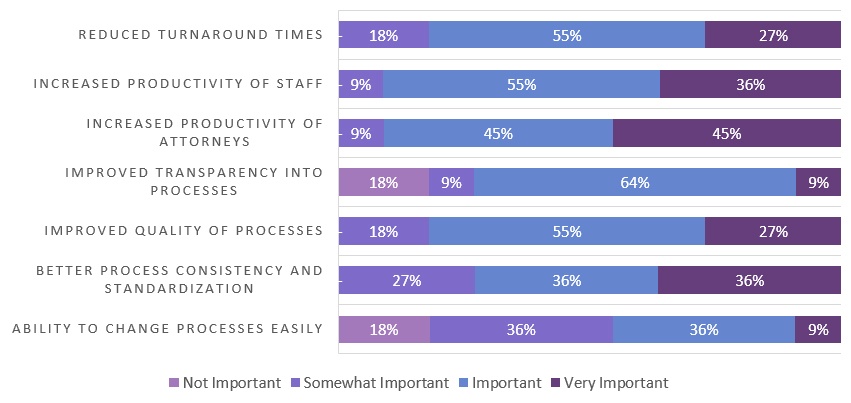
Workflow Automation in Intellectual Property Management
Intellectual Property groups have typically relied on their “docketing systems” as the central resource for managing task assignments, deadlines and other case-related information. While a traditional docketing system provides important country rules and PTO procedures, these systems tend to be more limited in their workflow capabilities to automate processes across the IPM lifecycle or to meet unique client-defined requirements.
In seeking to improve operational performance, we find that leading Intellectual Property groups are now embracing advanced workflow technology as a key to their success. Workflow solutions can deliver rapid returns on investment because they improve resource utilization, work-cycle times and quality-control costs. In addition to the efficiency and cost benefits, workflow solutions also benefit users by improving the visibility of and confidence in the work process. With defined workflows, previous “black box” processes are more open and accessible to the user, thereby increasing satisfaction and reducing frustration.
Over the last few years, our research and advisory work with IP Groups has identified a growing trend in the interest and need for broader, more end-to-end IPM process management. In 2011, a benchmarking study we conducted found that 36% of legal organizations reported process automation as a very important or high-priority focus area. By 2013, that number had nearly doubled to 70%. The most important drivers (see Fig.1) focus on core objectives, such as increased productivity (91%), improved quality of processes (82%) and better process consistency and standardization (72%).
Fig.1 The Biggest Drivers Of Workflow Automation and Legal Process Management

In considering the opportunities of workflow automation, we have identified the following “best practice” IPM processes as strong candidates for automation:
- Invention disclosure submission
- Trademark availability and use request
- Disclosure review and approval (e.g., patent review boards)
- Trademark search and clearance
- Global filing strategy
- Outside counsel assignment
- Prior art and technical literature search requests
- Application draft review and approval
- Office action draft review and approval
- Foreign filing decisions
- IDS and related art review and approval
- Maintenance fee payment review and approval
- Asset mapping (e.g., to products, technologies, projects)
- Review of newsworthy art, case law and other information
- Portfolio reporting
- Affidavit of use and related formalities
- Assignments
- Non-disclosure agreement request and approval
- License agreement reviews
- Billing review and approval (e.g., outside counsel e-Billing)
In reviewing the workflow capabilities of advanced IPM systems, we find strong capabilities in specific core IPM process areas. The solution vendors have worked closely with clients to identify and develop certain pre-defined workflows that are available to clients “out of the box.” Companies are usually able to modify these pre-defined workflows, although the level of configurability varies significantly between vendors.
Where the IPM systems differentiate themselves is in their ability to support unique, company-specific business processes that require custom workflows. The solution options have improved significantly in the last 12-24 months, with a number of providers introducing true BPM capabilities. With these more flexible and capable workflow modules, organizations can design, build and deploy custom workflows more easily and without the need for heavy technical development. Evaluating the various systems, however, requires a close examination of how the tools are architected and their ability to meet a client’s specific needs and use cases.


